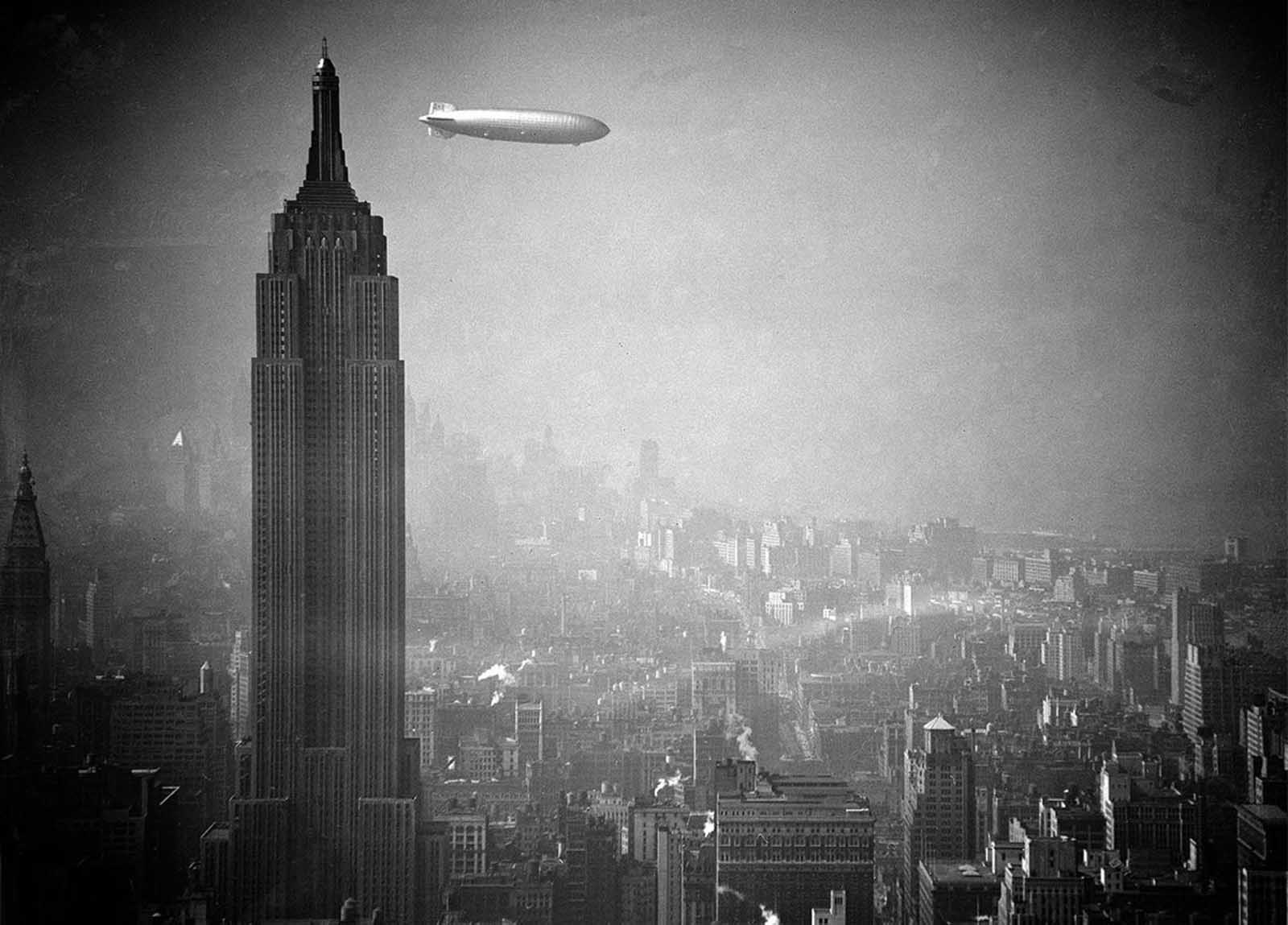The German zeppelin Hindenburg floats past the Empire State Building over Manhattan, on August 8, 1936, en route to Lakehurst, New Jersey, from Germany.
The history of airships begins, like the history of hot air balloons, in France.
After the invention of the hot air balloon in 1783, a French officer named Meusnier envisioned an airship that utilized the design of the hot air balloon but was able to be navigated.
In 1784, he designed an airship that had an elongated envelope, propellers, and a rudder, unlike today’s blimp. Although he documented his idea with extensive drawings, Meusnier’s airship was never built.

In 1905, pioneering balloonist Thomas Scott Baldwin’s latest airship returns from a flight over the City of Portland, Oregon, during the Lewis and Clark Centennial Exposition.
In 1852, another Frenchman, an engineer named Henri Giffard, built the first practical airship.
Filled with hydrogen gas, it was driven by a 3 hp steam engine weighing 350 lb (160 kg), and it flew at 6 mi/hr (9 km/hr). Even though Giffard’s airship did achieve liftoff, it could not be completely controlled.
The first successfully navigated airship, La France, was built in 1884 by two more Frenchman, Renard and Krebs.
Propelled by a 9 hp electrically-driven airscrew, La France was under its pilots’ complete control. It flew at 15 mi/hr (24 km/hr).

An airship flies above the White House in Washington, District of Columbia, in 1906.
In 1895, the first distinctly rigid airship was built by German David Schwarz. His design led to the successful development of the zeppelin, a rigid airship built by Count zeppelin.
The zeppelin utilized two 15 hp engines and flew at a speed of 25 mi/hr (42 km/hr). Their development and the subsequent manufacture of 20 such vessels gave Germany an initial military advantage at the start of World War I.
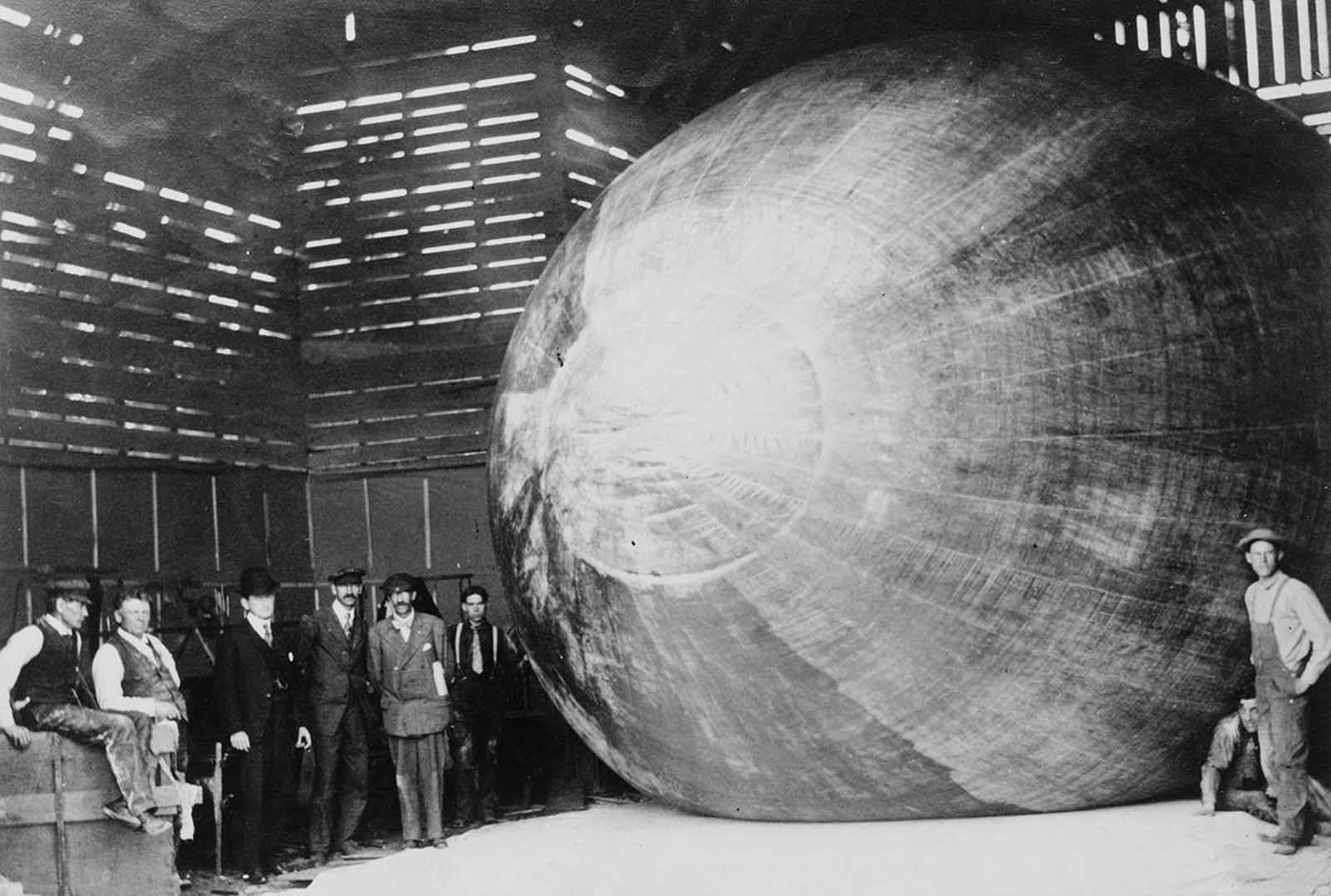
The Baldwin airship at Hammondsport, New York, in 1907. Thomas Scott Baldwin, second from left, was a U.S. Army major during World War I. He became the first American to descend from a balloon by parachute.
It was Germany’s successful use of the zeppelin for military reconnaissance missions that spurred the British Royal Navy to create its own airships.
Rather than duplicating the design of the German rigid airship, the British manufactured several small non-rigid balloons.
These airships were used to successfully detect German submarines and were classified as “British Class B” airships. It is quite possible this is where the term blimp originates—”Class B” plus limp or non-rigid.

French military dirigible “Republique” leaving Moisson for Chalais-Mendon, in 1907.
During the 1920s and 1930s, Britain, Germany, and the United States focused on developing large, rigid, passenger-carrying airships. Unlike Britain and Germany, the United States primarily used helium to give their airships lift.
Found in small quantities in natural gas deposits in the United States, helium is quite expensive to make; however, it is not flammable like hydrogen.

Zeppelin airship seen from the water, August 4, 1908.
Because of the cost involved in its manufacture, the United States banned the exportation of helium to other countries, forcing Germany and Britain to rely on the more volatile hydrogen gas.
Many of the large passenger-carrying airships using hydrogen instead of helium met with disaster, and because of such large losses of life, the heyday of the large passenger-carrying airship came to an abrupt end.
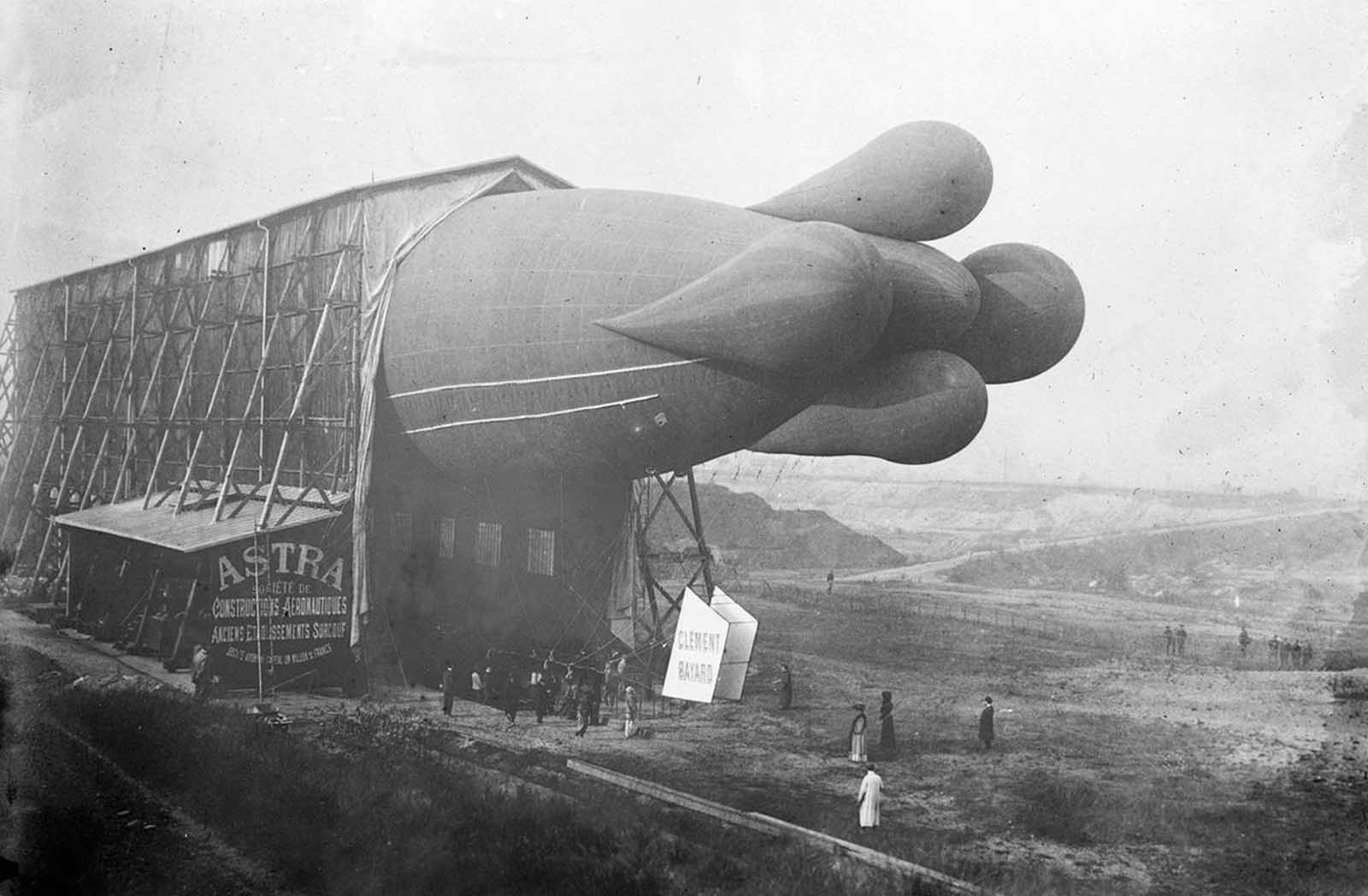
A Clement-Bayard dirigible in shed, France, ca 1908. The lobes on the tail, meant for stability, were removed from later models, as they were found to slow the craft in the air.

Wellman airship “America” viewed from the RMS TRENT, shown dragging her anchor, ca 1910.
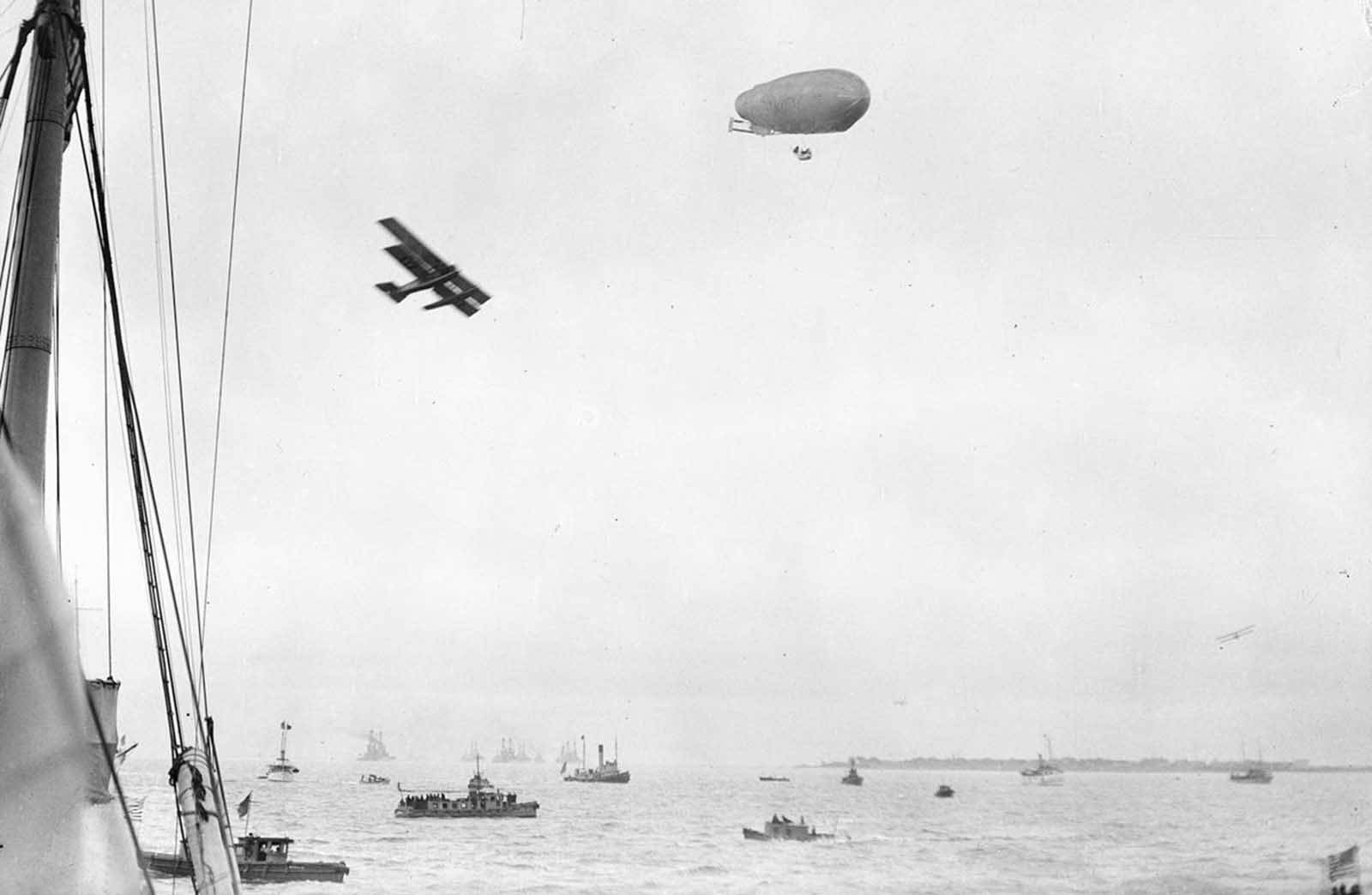
Boats, airplane, and airship, ca. 1922. Possibly the U.S. Navy’s SCDA O-1.

Luftskipet (airship) “Norge” over Ekeberg, Norway, on April 14, 1926.
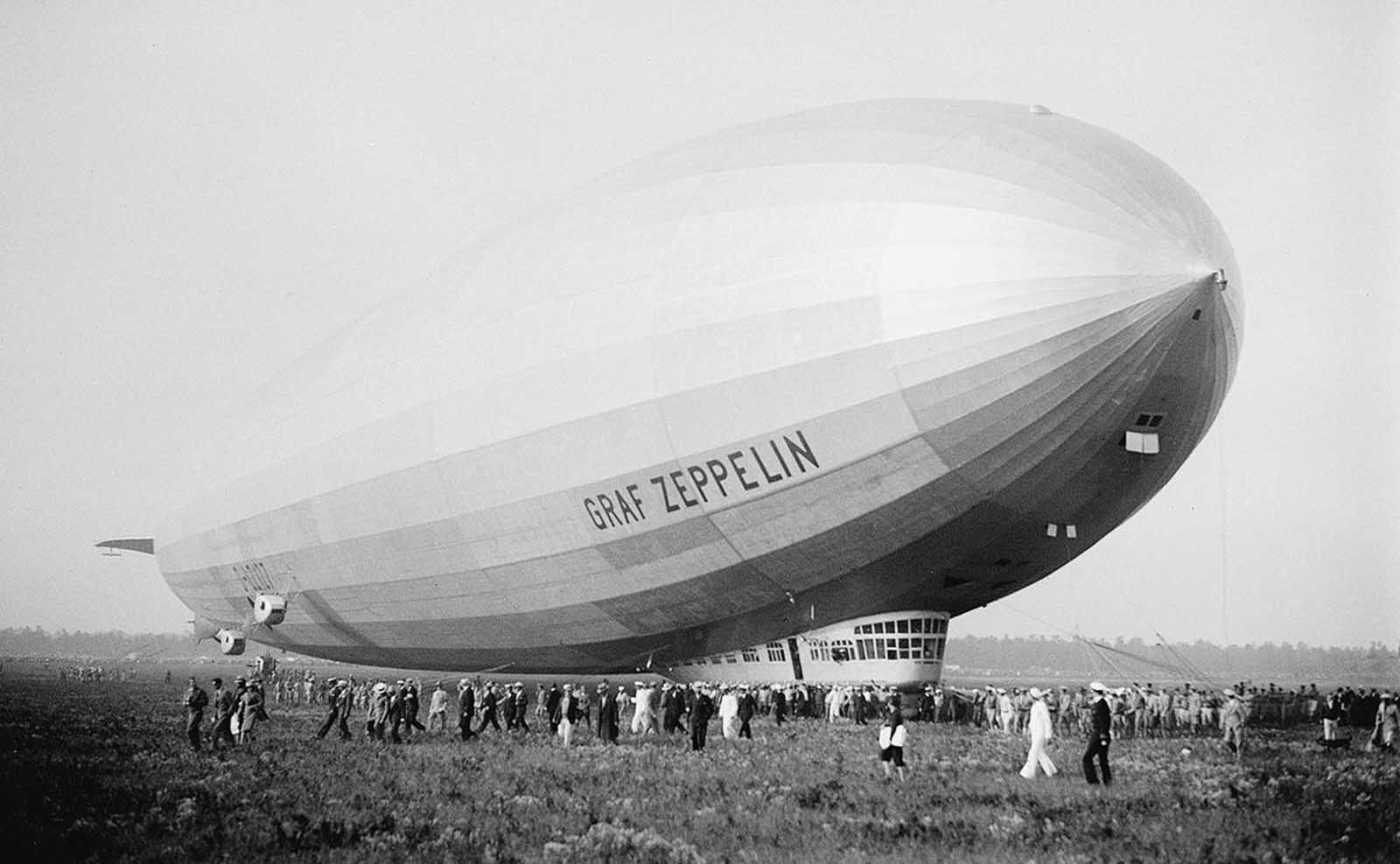
The giant German dirigible Graf Zeppelin, at Lakehurst, New Jersey, on August 29, 1929.

The Graf Zeppelin flies low over Tokyo before proceeding to Kasumigaura Airport on its around-the-world flight, on August 19, 1929.

A pair of Gloster Grebe fighter planes, tethered to the underside of the British Royal Navy airship R33, in October of 1926.

British M.P.s walk onto an airship gangplank, in Cardington, England, in the 1920s.
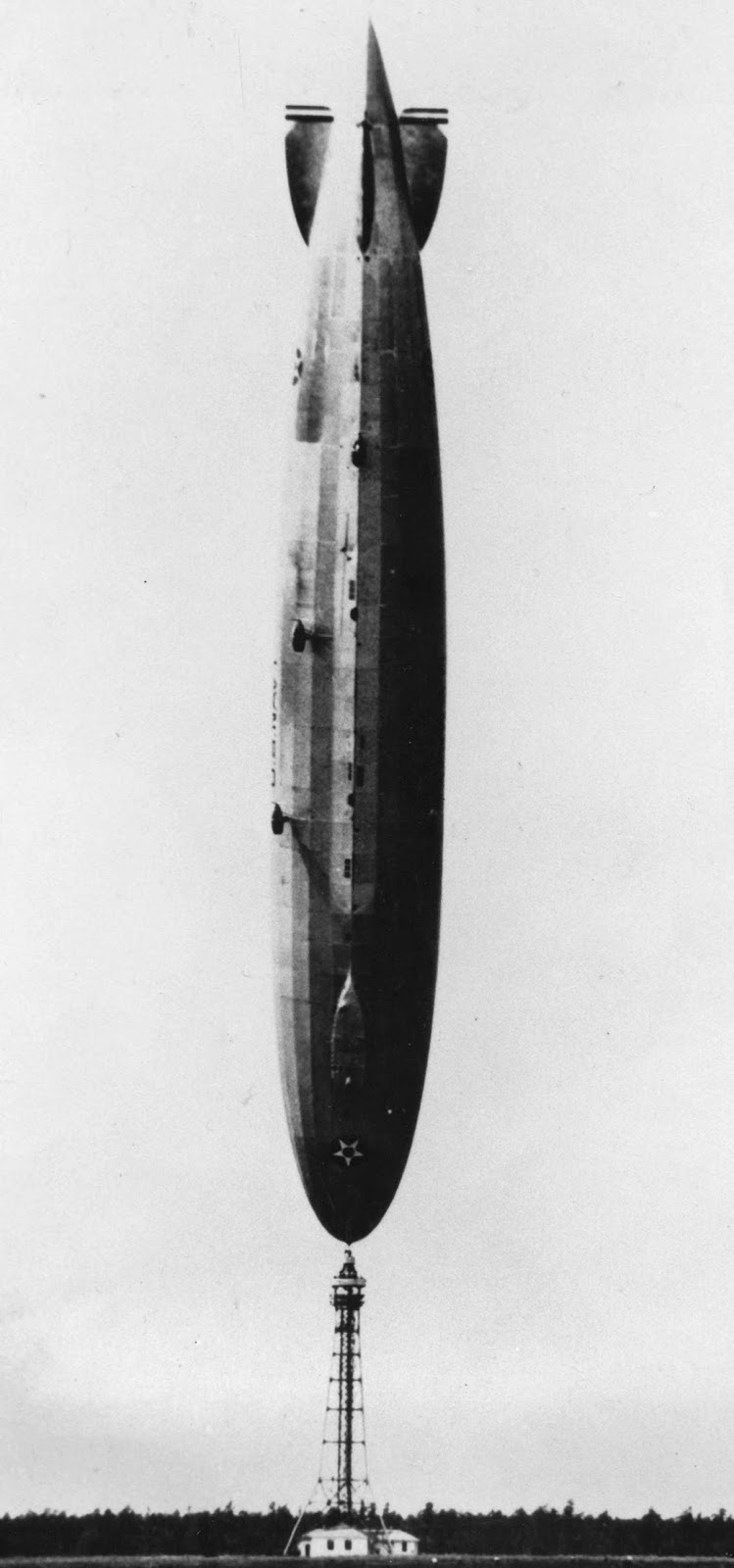
The U.S. Navy’s dirigible Los Angeles, upended after a turbulent wind from the Atlantic flipped the 700-foot airship on its nose at Lakehurst, New Jersey, in 1926. The ship slowly righted itself and there were no serious injuries to the crew of 25.
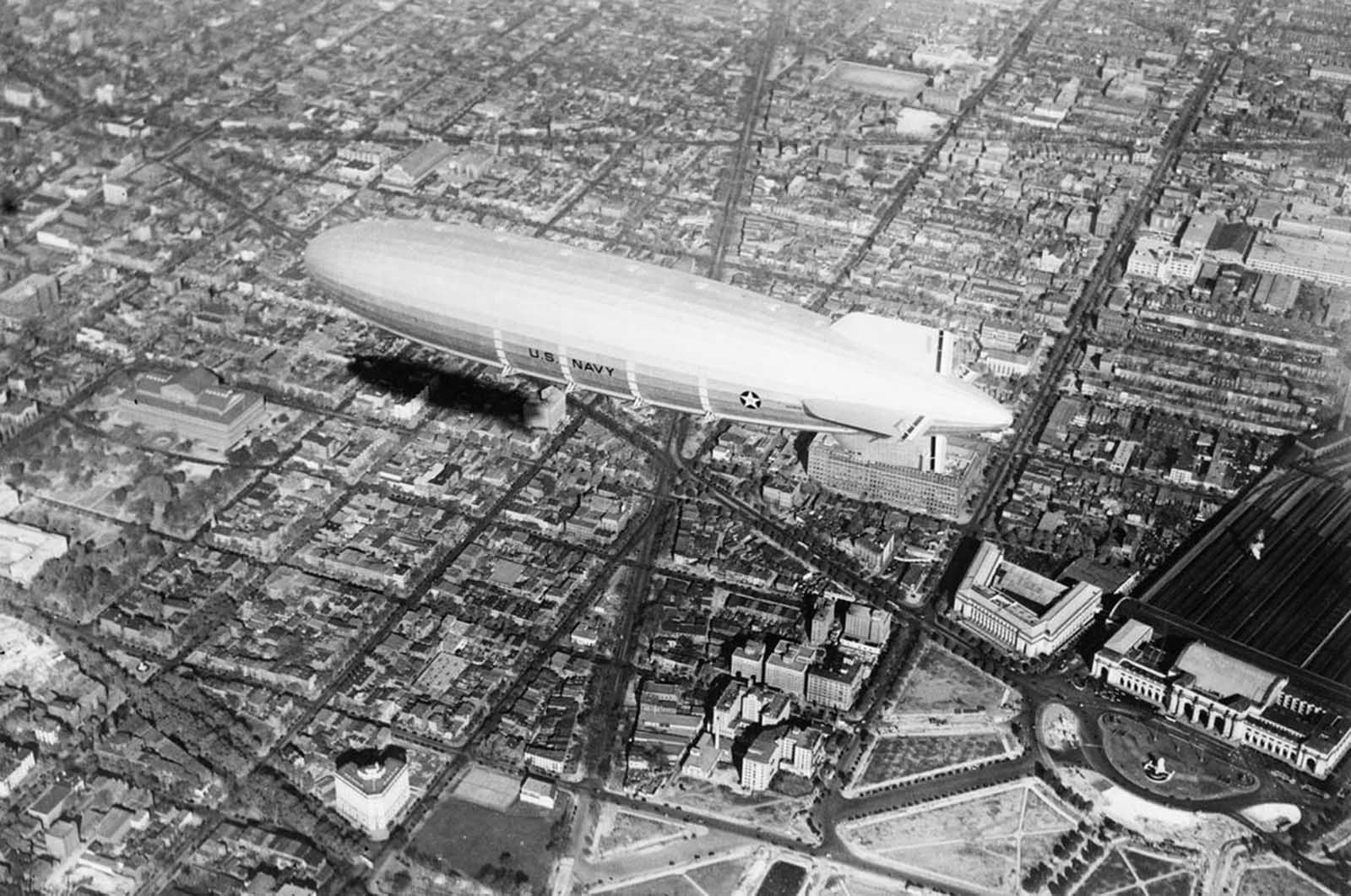
Aerial view of the USS Akron over Washington, District of Columbia, in 1931, with the long north diagonal of New Jersey Avenue bisected by the balloon and Massachusetts Avenue seen just beneath the ship.

Passengers in the dining room of the Hindenburg, in April of 1936.
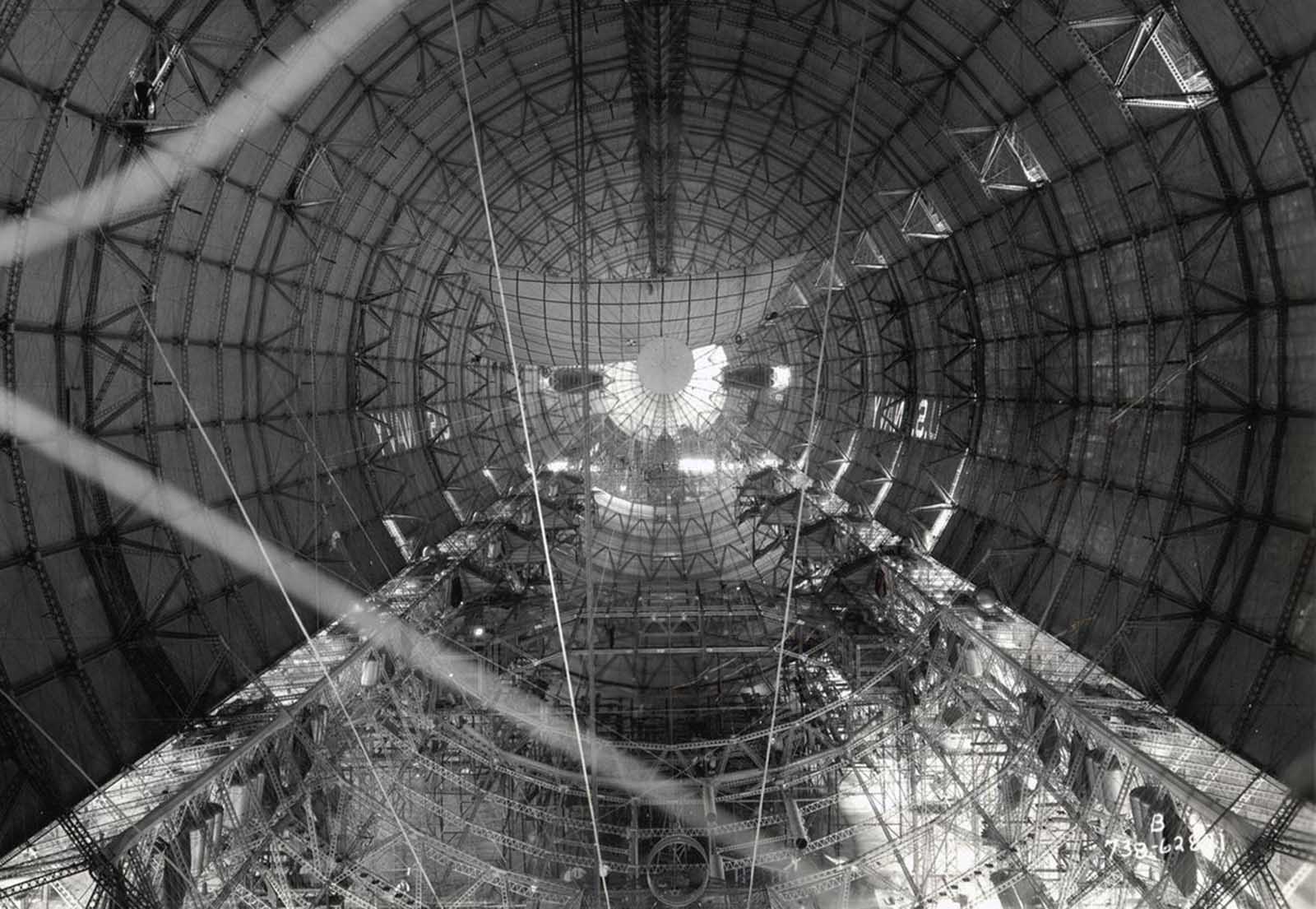
Interior hull of a U.S. Navy dirigible before gas cells were installed, ca. 1933.

The Graf Zeppelin over the old city of Jerusalem, April 26, 1931.

The mechanic of the rear engine gondola changes shift climbing inside the mantle of the airship, as the Graf Zeppelin sails over the Atlantic Ocean in a seven-day journey from Europe to South America, in August of 1933.
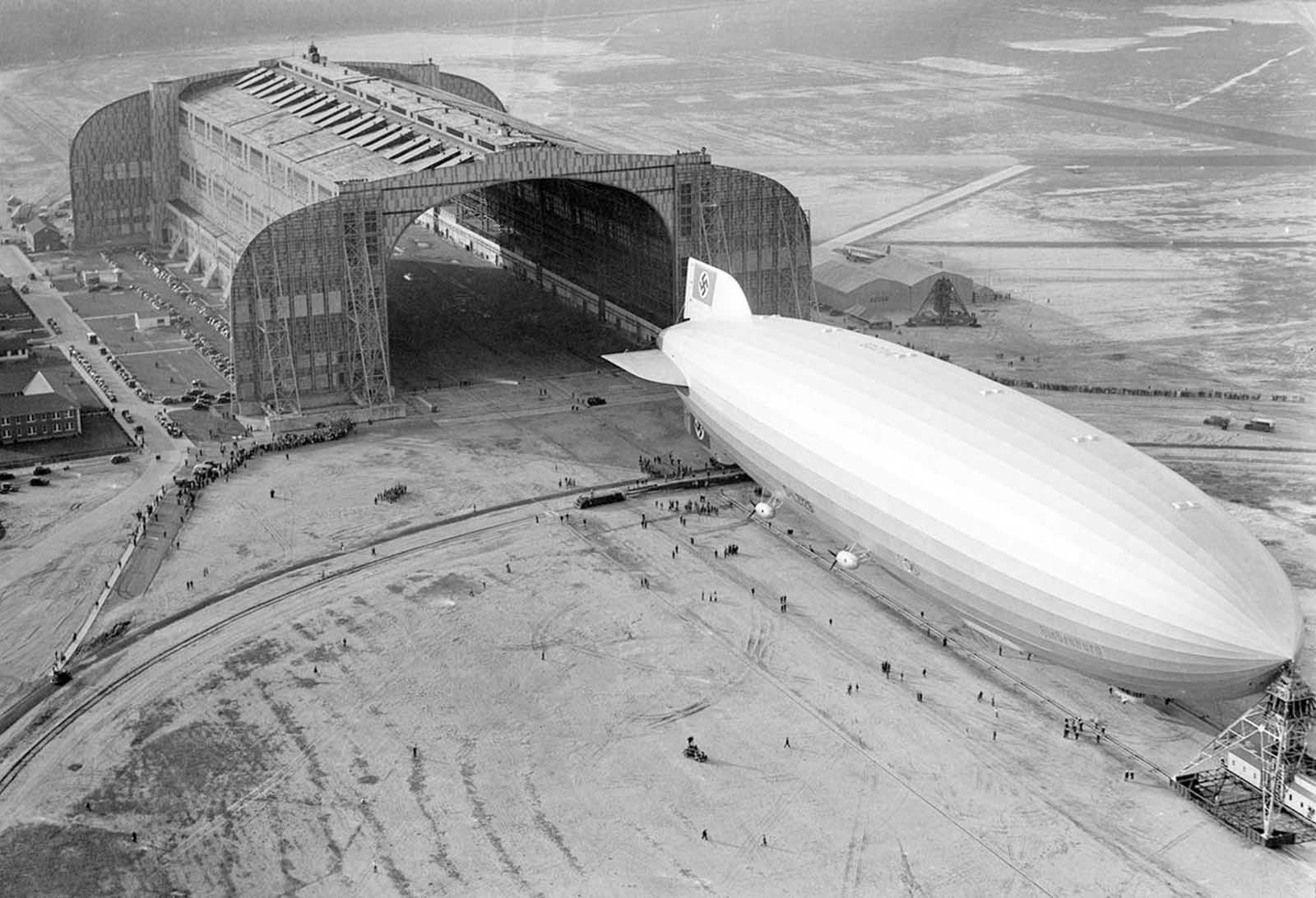
The German-built zeppelin Hindenburg trundles into the U.S. Navy hangar, its nose hooked to the mobile mooring tower, at Lakehurst, New Jersey, on May 9, 1936. The rigid airship had just set a record for its first north Atlantic crossing, the first leg of ten scheduled round trips between Germany and America.

The Hindenburg flies over Manhattan, on May 6, 1937. A few hours later, the ship burst into flames in an attempt to land at Lakehurst, New Jersey.

The German dirigible Hindenburg crashes to earth, tail first, in flaming ruins after exploding at the U.S. Naval Station in Lakehurst, New Jersey, on May 6, 1937. The disaster, which killed 36 people after a 60-hour transatlantic flight from Germany, ended regular passenger service by the lighter-than-air airships. Read more about this disaster.

The airship USS Macon, moored at Hangar One at Moffett Federal Airfield near Mountain View, California.
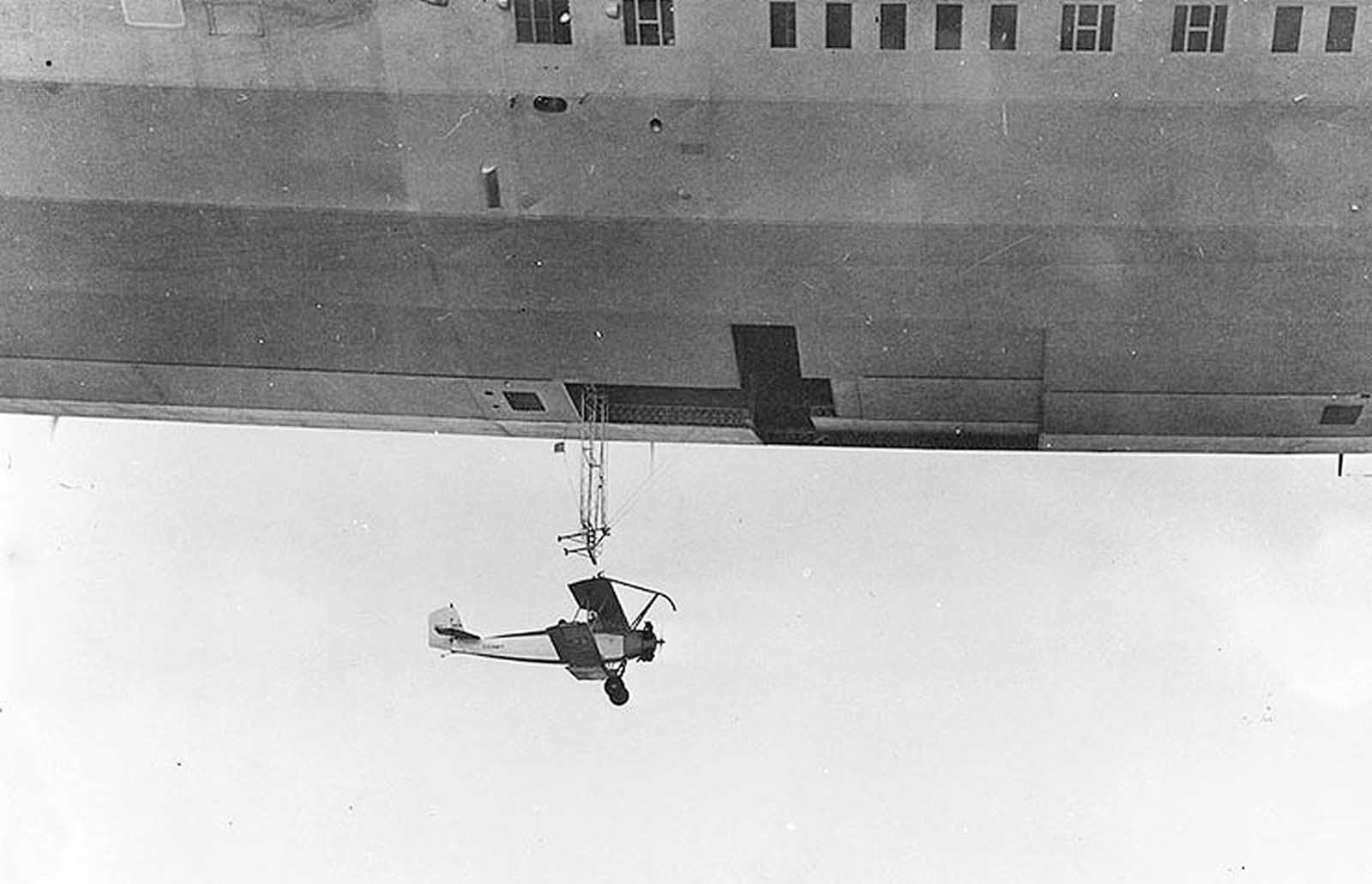
The USS Akron launches a Consolidated N2Y-1 training plane during flight tests near Naval Air Station at Lakehurst, New Jersey, on May 4, 1932.

The USS Los Angeles, moored to the USS Patoka.
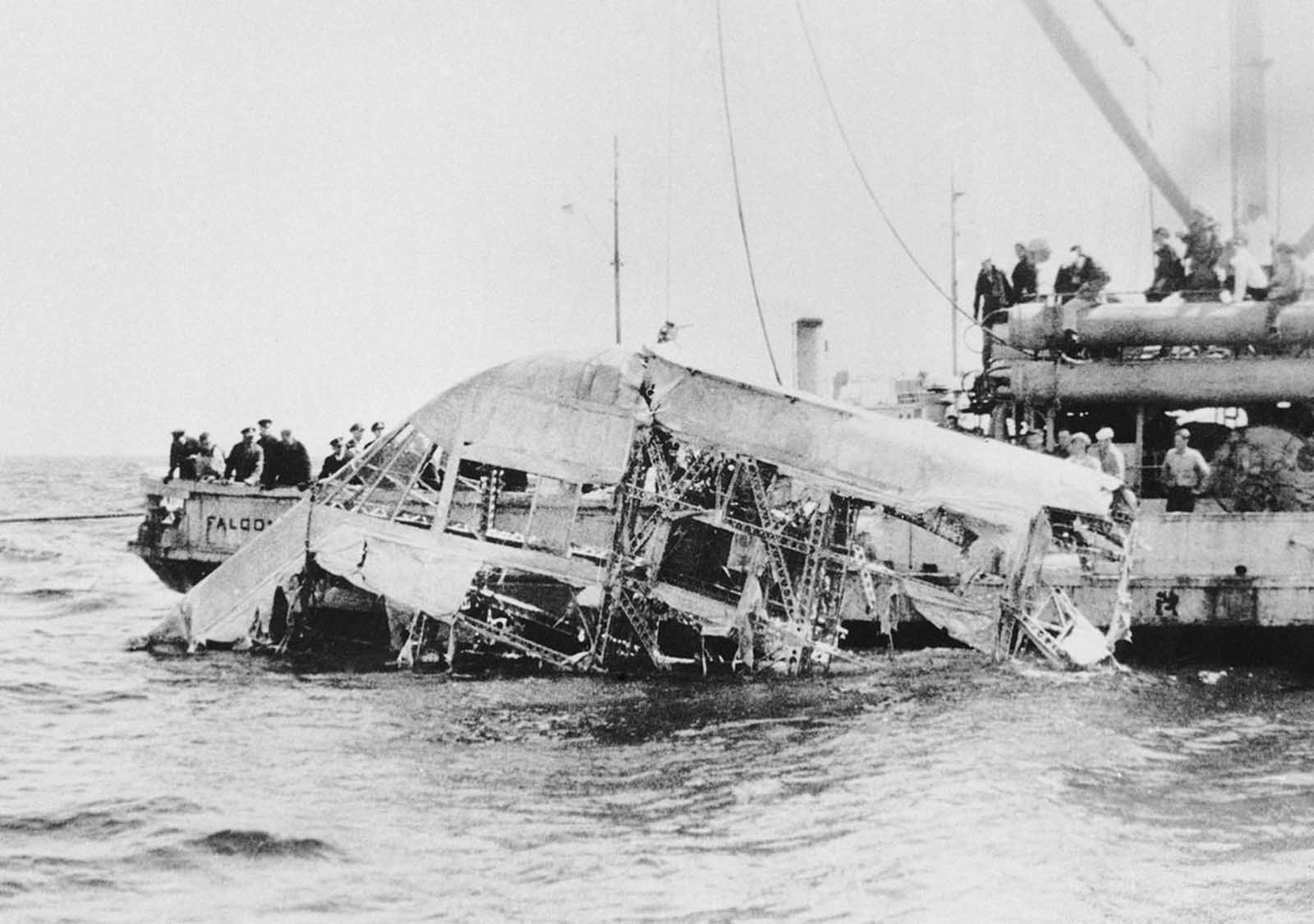
The wreckage of the naval dirigible USS Akron is brought to the surface of the ocean off the coast of New Jersey, on April 23, 1933. The Akron went down in a violent storm off the New Jersey coast. The disaster claimed 73 lives, more than twice as many as the crash of the Hindenburg. The USS Akron, a 785-foot dirigible, was in its third year of flight when a violent storm sent it crashing tail-first into the Atlantic Ocean shortly after midnight on April 4, 1933.

Sunset over the Atlantic finds a United States convoy moving peacefully towards it destination during World War II. A U.S. Navy blimp, hovering overhead, is on the lookout for any sign of enemy submarines, in June of 1943.
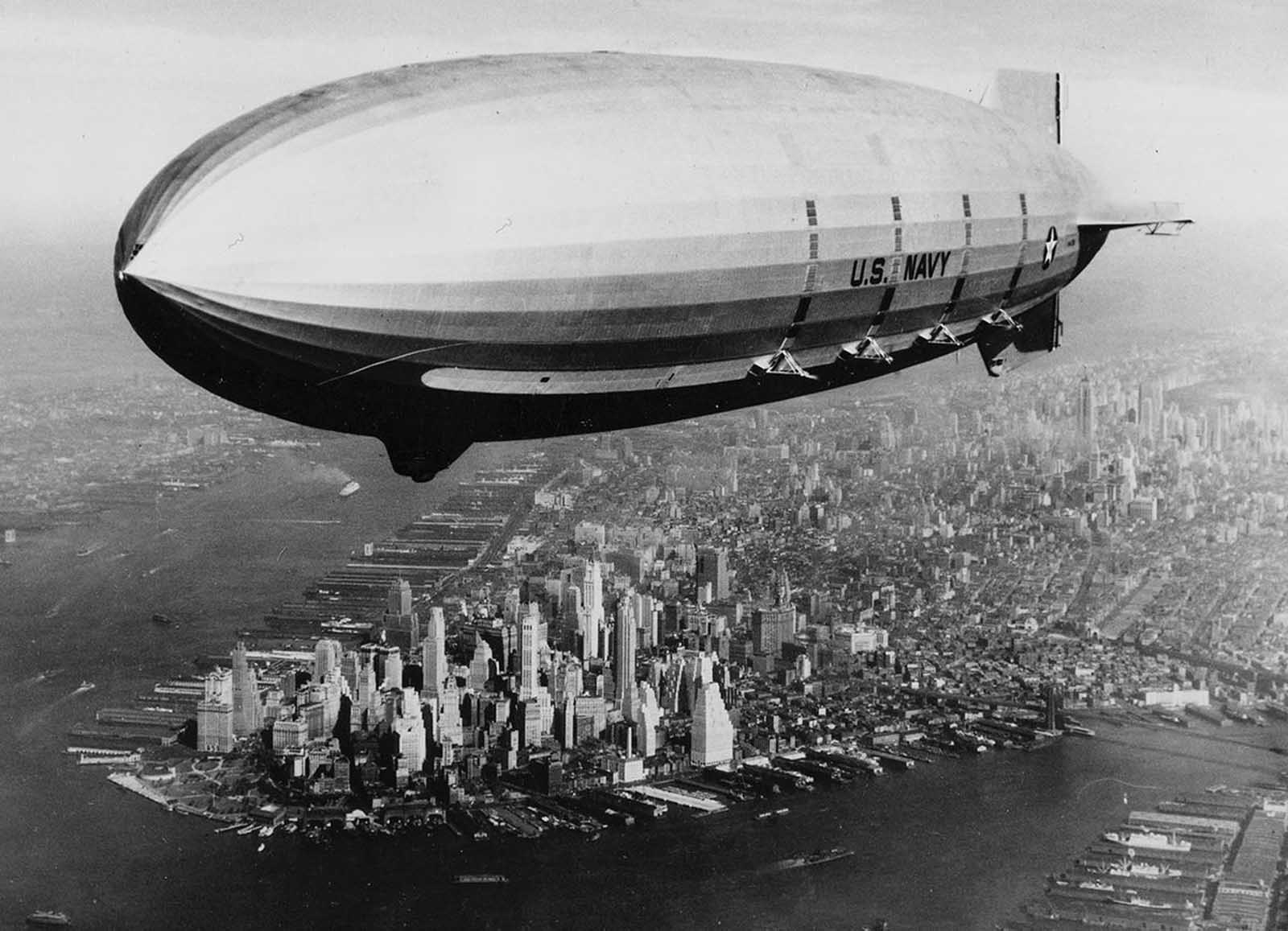
The USS Macon sails over lower Manhattan, on October 9, 1933.

At a Nevada nuclear test site test Site, on August 7, 1957, the tail of a U.S. Navy Blimp is photographed with the cloud of a nuclear blast in the background. The Blimp was in temporary free flight in excess of five miles from ground zero when it collapsed from the shock wave of the blast. The airship was unmanned and was used in military effects experiments. Navy personnel on the ground in the vicinity of the experimental area were unhurt.
(Photo credit: Library of Congress / U.S. Navy / AP).
